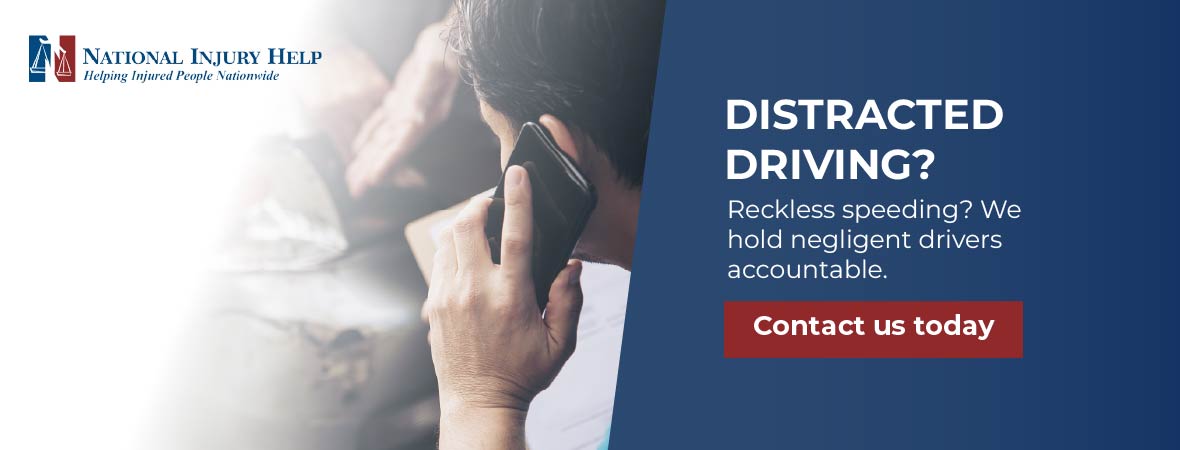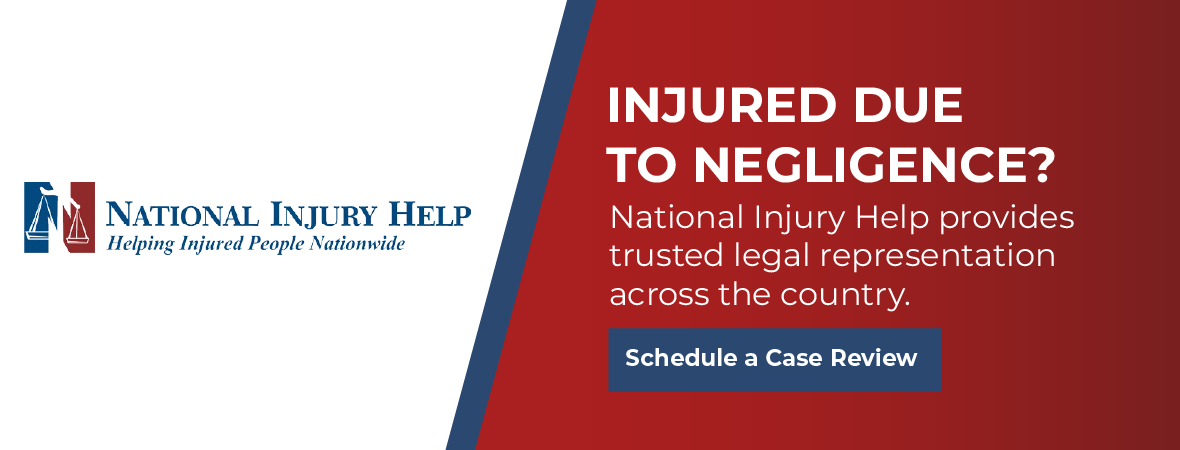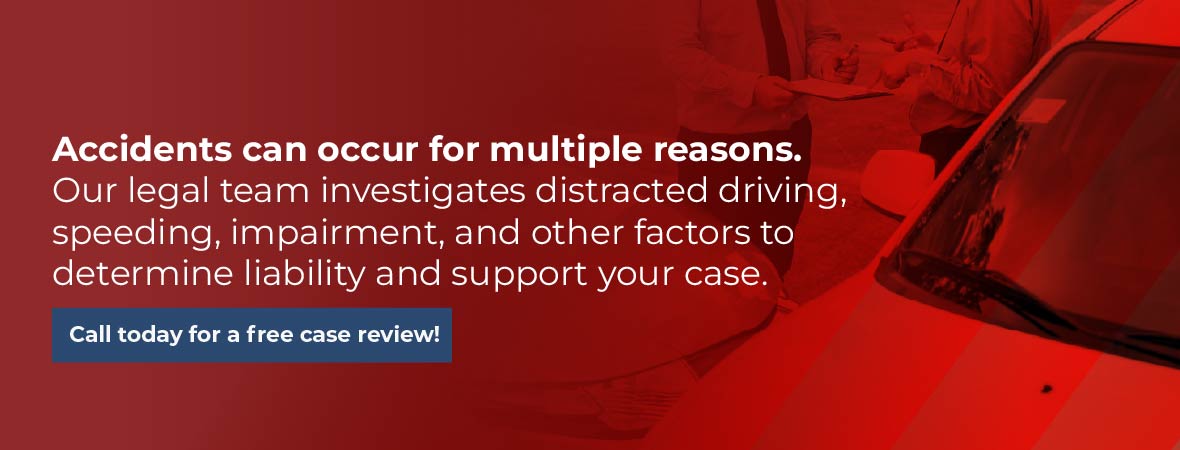Car accidents can happen in seconds, but the consequences can last a lifetime. Learn about the most common causes of crashes and how to protect your rights if you’ve been hurt. If a careless driver caused your injury, contact National Injury Help today. We are here to fight for the compensation you deserve.
Car crashes happen every day on American roads, whether you are easing through morning traffic in Atlanta, crossing the snowy passes of I-80 in Wyoming, or cruising the long, straight miles of I-95 along the East Coast.
According to the National Highway Traffic Safety Administration (NHTSA), an estimated 40,901 people were killed in motor-vehicle crashes nationwide in 2023. Accident statistics are down from 2022, yet it still means someone dies about every 13 minutes on U.S. roads.
We’ll focus on six themes: distracted driving, speeding and aggressive driving, impaired driving, weather and road conditions, driver fatigue, and poor road maintenance, then finish with practical advice on when to involve an attorney.
1. Distracted Driving
What counts as a distraction?
Anything that steals your eyes, mind, or hands from the job of driving:
- Texting, scrolling social media, or filming a quick video
- Eating a burger or sipping coffee while rolling forward
- Tapping a screen to change a playlist or punch in a new GPS route
- Turning to talk to back-seat passengers
- Reaching for items that slid off the seat
Nationwide, distracted driving killed 3,275 people and injured nearly 325,000 in 2023. Most states now have some version of a “hands-free” law. Fines can climb as high as $450 for repeat offenders, and a handful of states allow license suspensions after multiple violations.
Easy ways to stay focused
- Activate “Do Not Disturb While Driving” mode on your phone.
- Set playlists and GPS before you leave the driveway.
- Stow snacks in the trunk so you are not tempted to munch on the move.
- If a text truly can’t wait, pull into a parking lot, never the shoulder.
2. Speeding and Aggressive Driving
Speeding rarely travels alone. It brings friends like tailgating, weaving, and brake-checking. NHTSA estimates that speed and aggressive behavior contribute to roughly one-third of all fatal crashes each year.
Why it stays a problem
- Long rural highways make high speeds feel safe.
- Congested city traffic frustrates drivers, sparking angry maneuvers.
- Modern cars hide speed with quiet cabins and smooth suspensions.
At 70 mph you cover a football field every three seconds. Add a quick lane change or a sudden slowdown ahead, and you have a recipe for a multi-car pileup.
Simple fixes
- Use cruise control on open highways to keep your speed honest.
- Keep at least a three-second gap to the car ahead; double it in rain or snow.
- If another driver is tailgating, move over, let them pass and keep your stress low.
3. Impaired Driving (Alcohol, Drugs, and Medications)
Even with some of the strictest DUI laws on the books, impaired driving remains a leading killer. A blood-alcohol content (BAC) of 0.08% is illegal in all 50 states, but impairment starts sooner for many people. Recreational cannabis is now legal in more than half the country, yet driving “while high” is still forbidden everywhere. Prescription pain pills, sleep aids, and even strong cold medicines can also slow reaction time or cause drowsiness.
Know the penalties
- First-offense DUI often brings fines above $1,000, license suspension, mandatory education, and a criminal record.
- Many states add ignition-interlock devices after a high-BAC conviction.
- Causing injury while impaired can elevate charges to felonies and expose you to steep civil lawsuits.
Stay safe
- Designate a sober driver or use a ride-share.
- Check medication labels for “may cause drowsiness” warnings.
- Store cannabis and alcohol in the trunk on the way home to avoid temptation.
4. Weather and Road Conditions
America’s geography throws every type of weather at drivers, including flood, hurricane, fog, and dust storms.
Heavy rain cuts tire grip in half. Just ½-inch of water at 50 mph is enough for hydroplaning. Snow hides lane markings, and blowing dust can erase the horizon in seconds. Construction zones, everywhere from rural repaving projects to massive interstate expansions, add cones, uneven pavement, and narrow lanes that punish small steering errors.
Weather-wise driving tips
- Slow 5–10 mph below the limit at the first sign of rain or snow.
- Turn on low-beam headlights in fog or heavy rain so others see you.
- In dust storms or whiteouts, pull well off the roadway, turn off lights, and keep foot off the brake so following drivers don’t aim for your taillights.
5. Driver Fatigue
The Centers for Disease Control likens driving after 18 hours awake to having a BAC of 0.05%. After 24 hours, it mirrors 0.10%, well above the legal limit. Long-haul truckers, rideshare drivers on back-to-back shifts, and parents finishing late shifts are all at risk.
Warning signs
- Lane drifting or rumble-strip hits
- Missing an exit or road sign
- Frequent blinking or yawning
- Microsleep moments where you “come to” and realize you don’t remember the last mile
Fight drowsiness the smart way
- Schedule breaks every two hours or 100 miles.
- Share the wheel on trips longer than six hours.
- If you catch yourself nodding, stop at the next safe location and nap for 15–20 minutes.
6. Poor Road Maintenance
From potholes in the Rust Belt to crumbling bridge joints in the Deep South, infrastructure problems add sudden danger:
- Hitting a pothole at freeway speed can blow a tire or damage suspension.
- Faded lane lines make night driving confusing, especially in rain.
- Shoulder drop-offs in rural areas increase rollover risk if a wheel slips off the edge.
Report bad road conditions to your state’s transportation department. Many offer mobile apps that let you snap a photo and tag the location.
When to Call a Car Accident Lawyer
Even careful drivers can be rear-ended by someone texting at 65 mph or sideswiped by a fatigued trucker. An experienced personal injury attorney can:
- Collect police reports, dash-cam video, and expert analysis before evidence disappears.
- Deal with insurance adjusters who may pressure you into quick, low settlements.
- Explain comparative-fault rules in your state, which can affect how much compensation you receive.
- Front costs for investigators and medical experts, then recover fees only if you win or settle.
Most reputable firms offer free initial consultations, so you risk nothing by asking questions early. Keep copies of every medical bill, repair estimate, and prescription receipt, you will need them to prove damages.
Contact a Car Accident Lawyer Today
Even the most safety-minded driver can cross paths with someone who texts at 70 mph or drifts asleep behind the wheel. If a crash leaves you injured, early legal guidance preserves evidence, navigates comparative negligence rules, and fends off low offers from insurance adjusters.
Our team offers free consultations, and we charge no fee unless we recover compensation for you. Call 1 (800) 214-1010 today, and let us handle the legal fight while you focus on healing and getting back on the road safely.








